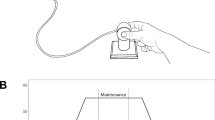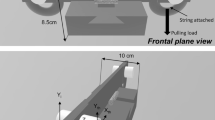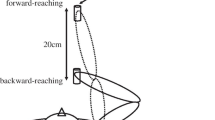Abstract
The aim of this study was to determine the effect of age on the modulation of forces produced by the digits and to determine the effects of practice on the control of these forces in young and older adults. Young (n=14, 19–28 years) and old (n=12, 67–75 years) adults used a precision grip to perform a variable force-tracking task (sine wave, 5–25% of maximum voluntary force) with their dominant hand. Participants performed 100 practice trials over 2 consecutive days. Results indicated that both groups improved accuracy of force tracking as a result of practice. Younger adults performed the task at a higher level in pre- and post-test conditions compared with older adults. Younger adults showed improvements in force control in force generation and release phases. Older adults reached performance levels comparable with younger adults’ pre-test performance, but only after extended practice. In contrast to young adults, older adults’ performance during the force release phases remained quite variable. These data suggest that older adults are impaired in the accurate release of grip force. Varied force release patterns that disrupt the precision of force modulation may contribute to older adults’ diminished dexterous abilities.





Similar content being viewed by others
Notes
The maximum force of the younger participants was not significantly greater than the maximum force of the older adults; t(19.10)=−0.11, P=0.91; My=48.87, SDy=10.11, Mo=49.44, SDo=14.67
Since no age differences in MVC occurred, CV seems to be an appropriate measure to show variations between the four phases of the sine wave
References
Burnett RA, Laidlaw DH, Enoka RM (2000) Coactivation of the antagonist muscle does not covary with steadiness in old adults. J Appl Physiol 89:61–71
Cole KJ (1991) Grasp force control in older adults. J Mot Behav 23:251–258
Cole KJ, Rotella DL (2001) Old age affects fingertip forces when restraining an unpredictably loaded object. Exp Brain Res 136:535–542
Cole KJ, Rotella DL, Harper JG (1998) Tactile impairments cannot explain the effect of age on a grasp and lift task. Exp Brain Res 121:263–269
Cole KJ, Rotella DL, Harper JG (1999) Mechanisms for age-related changes of fingertip forces during precision gripping and lifting in adults. J Neurosci 19:3238–3247
Eliasson AC, Gordon AM (2000) Impaired force coordination during object release in children with hemiplegic cerebral palsy. Dev Med Child Neurol 42:228–234
Flanagan JR, Wing AM (1993) Modulation of grip force with load force during point-to-point arm movements. Exp Brain Res 95:131–143
Galganski ME, Fuglevand AJ, Enoka RM (1993) Reduced control of motor output in a human hand muscle of elderly subjects during submaximal contractions. J Neurophysiol 69:2108–2115
Hackel ME, Wolfe GA, Bang SM, Canfield JS (1992) Changes in hand function in the aging adults as determined by the Jebsen test of hand function. Phys Ther 72:373–377
Jagacinski RJ, Min-Ju L, Fayyad EA (1995) Generalized slowing in sinusoidal tracking by older adults. Psychol Aging 10:8–19
Knight CA, Kamen G (2004) Enhanced motor unit rate coding with improvements in a force-matching task. J Electromyogr Kinesiol 14:619–629
Laidlaw DH, Kornatz KW, Keen DA, Suzuki S, Enoka RM (1999) Strength training improves the steadiness of slow lengthening contractions performed by old adults. J Appl Physiol 87:1786–1795
Lewis SR, Duff SV, Gordon AM (2002) Manual asymmetry during object release under varying task constraints. Am J Occup Ther 56:391–401
MacKenzie C, Iberall T (1994) The grasping hand. Elsevier, North-Holland, Amsterdam
Newell K (1986) Constraints on the development of coordination. In: Wade M, Whiting HTA (eds) Motor development in children: aspects of coordination and control. Martinus Nijhoff, Boston, pp 232–256
Newell KM, McDonald PV (1994) Information, coordination modes and control in a prehensile nforce task. Hum Mov Sci 13:375–391
Oldfield RC (1971) The assessment and analysis of handedness: the Edinburgh inventory. Neuropsychologia 9:91–113
Salthouse TA (1985) Speed of behavior and its implications for cognition. In: Birren JE, Schaie KW (eds) Handbook of the psychology of aging. Van Nostrand Reinhold, New York, pp 400–426
Semmler JG, Steege JW, Kornatz KW, Enoka RM (2000) Motor-unit synchronization is not responsible for larger motor-unit forces in old adults. J Neurophysiol 84:358–366
Shipley WC (1986) Shipley Institute of Living Scale. Western Psychological Services, Los Angeles
Shumway-Cook A, Woollacott M (2001) Motor control: theory and practical applications. Lippincott Williams& Wilkins, Baltimore, Md.
Spiegel KM, Stratton J, Burke JR, Glendinning DS, Enoka RM (1996) The influence of age on the assessment of motor unit activation in a human hand muscle. Exp Physiol 81:805–819
Spirduso WW (1995) Physical dimensions of aging. Human Kinetics, Champaign, Ill.
Taylor AM, Steege JW, Enoka RM (2000) Increased variability of motor unit discharge rate decreases the steadiness of simulated isometric contractions. Physiologist 43:321
Vaillancourt DE, Newell KM (2003) Aging and the time and frequency structure of force output variability. J Appl Physiol 94:903–912
Vaillancourt DE, Larsson L, Newell KM (2003) Effects of aging on force variability, single motor unit discharge patterns, and the structure of 10, 20, and 40 Hz EMG activity. Neurobiol Aging 24:25–35
Voelcker-Rehage C, Stronge AJ, Alberts JL (2005) Age-related differences in working memory and force control under dual-task conditions. Aging Neuropsychol Cogn (in press)
Wechsler D (1997) Wechsler adult intelligence scale III. The Psychological Corporation, San Antonio, Tex.
Westling G, Johansson RS (1984) Factors influencing the force control during precision grip. Exp Brain Res 53:277–284
Williams ME, Hadler NM, Earp JA (1990) Manual ability as a marker of dependency in geriatric women. J Chronic Dis 35:115–122
Wing AM, Haggard P, Flanagan JR (1996) Hand and brain. Academic Press, San Diego, Calif.
Yao W, Fuglevand AJ, Enoka RM (2000) Motor-unit synchronization increases EMG amplitude and decreases force steadiness of stimulated contractions. J Neurophyiol 83:441–452
Acknowledgements
This project was supported by a seed grant from the Center on Aging and Cognition: Health, Education, and Training. We thank Emiko Suzuki for her assistance in data collection and Erik M. Norrell for his assistance in data analysis.
Author information
Authors and Affiliations
Corresponding author
Rights and permissions
About this article
Cite this article
Voelcker-Rehage, C., Alberts, J.L. Age-related changes in grasping force modulation. Exp Brain Res 166, 61–70 (2005). https://doi.org/10.1007/s00221-005-2342-6
Received:
Accepted:
Published:
Issue Date:
DOI: https://doi.org/10.1007/s00221-005-2342-6




